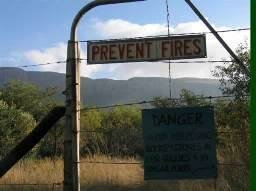Home > Don't just hike > Interesting > Fire
Don't play with ...
Fire
The facts and the fiction
†
How does the whole phenomenon of fire affect and drive our African ecosystem.
†
The following should be of interest in order to clarify the confusion and myths surrounding the whole fire scenario.
†
Africa and fire are intertwined.† In fact, fire is an integral component of the ecosystem.† The exclusion of fire from the African savanna often culminates in an irreversible and negative end, such as:
- bush encroachment where shrubs, thickets and trees literally envelop once pristine grasslands, and
- transformation of the grass component from palatable perennials to unpalatable annuals.†
†
Concomitant with these factors is the overall loss in the productive capacity of the land.† The African savannas as well as our grassland regions are a direct consequence of the evolutionary and moulding force that fire possesses.† It is this force that prevents the savanna from progressing a step further towards woodland or scrub forest.
†
How do natural fires occur?††
It is no coincidence that the savanna and grassland regions of Africa possess some of the highest lightning frequencies on earth.† These lightning strikes can ignite the dry and parched vegetation in an instant.† This is exactly what often occurs in our savanna and grassland regions.† The following are the necessary preconditions for a fire to really take hold.
- a large quantity of dry and moribund vegetation, i.e. a substantial fuel load,
- low relative humidity characteristic of the end of the dry season (winter),
- high air temperatures which again accompany the termination of winter, and
- winds of considerable velocity.
†
Certain seeds will only germinate if they are exposed to fire.† Fire resistant or tolerant plants are widely encountered in Africa.† This is normally manifested in the production of thick bark as well as thick underground woody roots.
†
The Melville Koppies Ecosystem.† Over the years, the
Melville Koppies Nature Reserve has been subjected to numerous fires.† Most of them are of accidental and malicious nature.† During the winter of 1998, the upper section was again burnt, which was to the Koppies disadvantage as it had been subjected to accidental burns during the two previous years.†† This constitutes a case of over-burning which has a deleterious effect on the grass.† However, the lower portion of the eastern section has been subjected to a fire exclusive management policy.† The results have been just as harmful!† Melville Koppies (lower eastern section) serves as an excellent example of how grassland can be transformed to the thicket and woodland in the absence of fire.
†
What can be gauged from this?† When fires are planned and properly managed, they can be extremely potent management tools.† The resilience and adaptations that our savannas and grasslands ecosystems exhibit regarding fire bears testimony to the scientific belief that the vegetation of Africa, apart from its tropical and temperate forests, has evolved over the millennia to cope with fire.† One must bear in mind that this does not justify burning the same piece of land year in and year out.† This form of abuse can often lead to the deterioration of the grass, it is replaced by hardy unpalatable and tufted grass species.† If a burn is to be undertaken, it should be done in an informed and scientific manner.
†
Only make a fire in the designated areas, make sure it is doused completely†and be careful that you donít start a bush fire.


